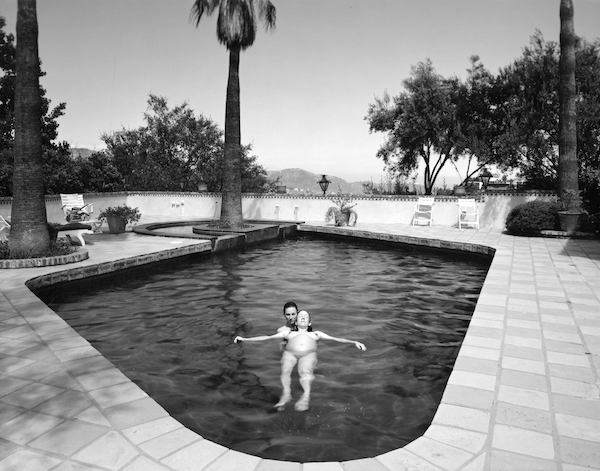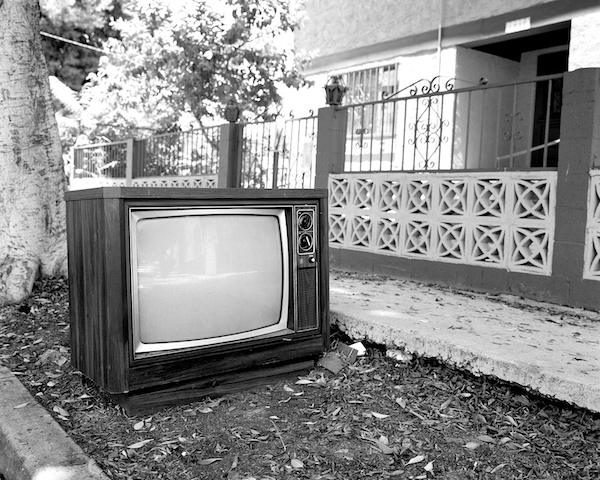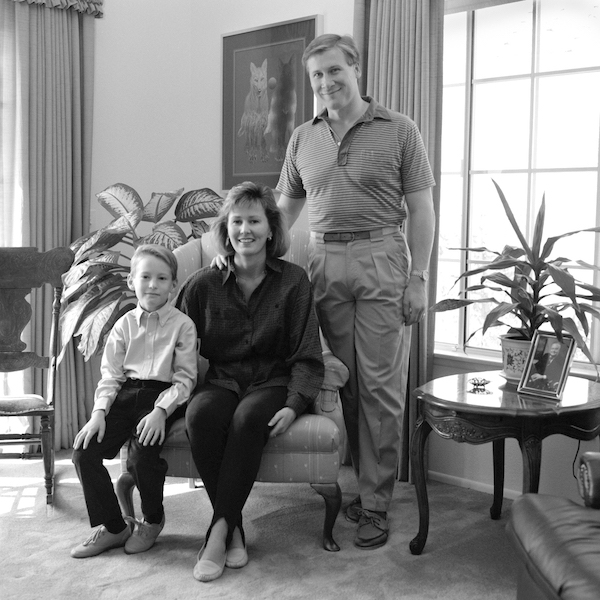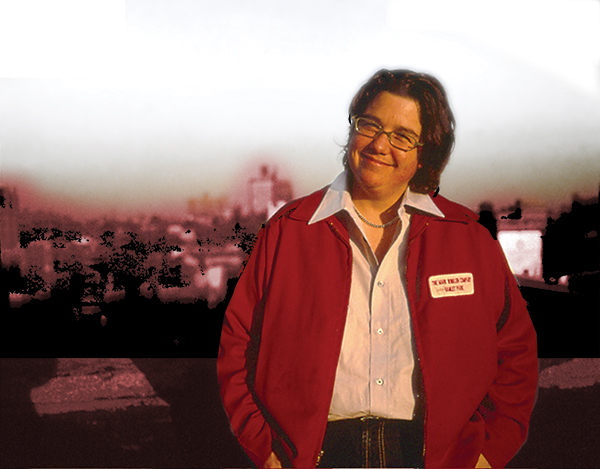California is known as the land of fruits and nuts. And it’s true, we’ve got wacky environmentalists, kooky lefty liberals and fruity homosexuals. And artist Catherine Opie actually fits all three categories, sans the loaded adjectives. Nothing wacky about Cathy, and nothing kooky about her politics, and certainly nothing fruity about her sexuality. But why does California attract such a rambunctious group of people? I’m hoping Ms. Opie can give me some answers.
I recently had the opportunity to sit down with Opie, who was just back from Santa Fe, New Mexico, where she was the only Los Angeles artist selected to be in the SITE Biennial. There she showed her new series of children’s portraits. And portraiture is what she’s famous for. But I was more interested to talk about her survey show at the Orange County Museum of Art, where Opie’s work is more about California.

Catherine Opie, Untitled #1 from “Freeway” series, 1994
When I arrived at her house in the historic West Adams district of central Los Angeles, I experienced a slight sense of deja vu. I had just seen her OCMA show “In and Around Home,” and many of the photographs in the exhibit were taken, well, at her home, which she shares with her partner and their two children and many pets. Her dwelling was very comfortable and welcoming. A short wooden picket fence opened into a front yard filled with big shade trees and children’s toys, complete with an anti-Bush banner hanging on the cool breezy porch. Constant activity was going on when I was greeted by the artist and a very friendly Doberman: a housekeeper was running the vacuum in the living room and in the kitchen workers were fixing the plumbing. Opie was very gracious, offering me something to drink, but then we quickly got down to business, as she had to take the plumber to the local hardware store for a part.
One thing is for sure, she’s very proud of her show in Orange County, which brings together many elements of her work she’s been addressing for almost 20 years now, and two new series of photographs never exhibited before here in So. Cal. When I mistakenly referred to it as a retrospective, she reminded me, “I’m still young!” At 45, her baby-face features and boyish thick mop of brunette hair (not a single grey!), reveal an artist very comfortable with herself and her art. She clarified for me, “It’s a very specific show in regards to my ideas around community and landscape as well as Southern California. A lot of people always think of me around the portraits, and never really go beyond that even though that’s only a quarter of my work. But it always goes back to that, that I made this body of work in the early ’90s.” She goes on to explain how the portrait series actually were “a little bit off what I normally make.” And that’s what makes the Orange County show distinctive, the exclusion of her portraits, which were an extension of the theme community, but more specifically, her own milieu and particularly during the AIDS crisis in the homosexual world.

Catherine Opie, Miggi & Ilene, Los Angeles, California, 1995
As Opie was talking about all this, it occurred to me that I had not ever looked beyond the surface of her photos in that way. I never really considered her work as political. For example, her famous freeway photos are gorgeous to look at with their careful composition, wonderful light and abstract quality. But they’re also about destruction, and ultimately, political. And sure, I knew her portraits were political in the subculture kind of way; even dysfunctional families can be considered a political topic. But her politics go beyond that. Opie is concerned about the bigger picture. And living in California fostered a lot of that thinking.
In that sense, Opie’s show at OCMA brings the photographer full circle. Although she’s not a native, (she moved out from Ohio at age 13) she grew up in Orange County. And “In and Around Home” documents her life and neighborhood in central Los Angeles. But the show starts in Valencia, with her MFA show at CalArts, where her first concerns with the raping of landscape were documented. Tenderly shooing her Doby away for the umpteenth time, she mused, “What disturbs me more is the use of landscape in California. When I moved from Ohio in the early ’70s, we grew up surrounded by acres of cornfields. And I got to grow up surrounded by beautiful landscape. Orange County was still orange groves. When we moved to California, we moved to this burgeoning Master Plan community called Poway Rancho Bernardo. So I watched from my backyard all of this development happen. And it used to be vineyards and rocks that I climbed on, and sage and chaparral, and I’m really interested in nature. I really like nature as a person. I mean, we have chickens!”

Catherine Opie, Abandoned TV
It so happens, “Master Plan” became the title of her thesis show. Most artists would be hesitant to include their college work in a mid-career survey, but OCMA curator Elizabeth Armstrong insisted on including “Master Plan,” when Opie mildly suggested it and dusted off the negatives.
“Master Plan,” is a body of work that chronicles a tract-housing project under construction in Valencia where Opie was attending school from 1986-88. The work is very conceptual and some of the photographs are not her strongest work when viewed individually. But as an installation, it holds its own, and is not even dated in the least. Her message and what Opie is trying to communicate still rings true today. “For me it was going beyond the image, and really talking more about people’s choices in terms how they create community and also the white flight from the urban environment. I came from the suburbs. I was a suburban country club kid. Why do these environments exist? Why do people have rules and regulations within these environments? What do they serve? And really trying to explore that.”
Most of the photos in “Master Plan” are rather banal and flat. For instance the photograph of the Troidal family, who were interviewed and became part of the project, reads like a straight studio portrait, nothing particularly special. The family’s kitschy décor became still life photographs. At first glance, it appears Opie might be mocking the people who go for that style of living, surrounding themselves with bad taste so bad, even John Waters would not find it terribly interesting. When I suggested this, she set me straight immediately. “I was interested in not just [taking pictures of] it, but why people made those choices.” I did however get Opie to agree that living in a gated community would be a cookie-cutter hell of offensive blandness. “Yeah, there’s a little bit of imaging it that way, like, wow, how tacky and horrible these are and I’m glad I don’t choose to live in that kind of environment.” But ultimately she is more concerned about the drastic alterations to the landscape that such a mainstream lifestyle requires. She elaborates, “Part of the problem is the fact that the resources that it takes to maintain these developments is completely unprecedented in relationship to what California can do in providing water and energy. So what bothers me most about these communities is that they’re not approached from some kind of sustainability. That’s what bothers me the most, is watching this major acreage go, but every single house in Palmdale at this point, the technology has, that they can include solar, that goes into the grid. So you don’t have Stage 3 Alerts anymore! So these housing developments are only doing it to profit from it. But it has nothing about giving back to California as a state, or the notion of nature.”

Catherine Opie, Troidal Family, 1986-88
Fortunately for Opie, she has an ocean breeze coming through her Craftsman-style home, because I don’t know if she could handle the guilt if she had to use air-conditioning, (LA was experiencing a heat wave at the time.) It was refreshing to hear an artist talk about topics like environment, community and politics. Artists are typically known for their self-indulgence, but Opie couldn’t be further from this stereotype. And her art works beautifully with her politics. Take for instance her Surfer photographs. A whole room is dedicated to that series at OCMA, and you can practically feel the ocean mist and smell the sea salt when surrounded by the large scale works. This series doesn’t seem to fit with the others in the exhibit, but after hearing Opie’s manifesto, its inclusion is necessary. Opie is about California, and we can’t just skip the beaches and that community.
So is California to blame for spawning liberal environ-mentalists? This beautiful terrain replete with mountains, deserts, forests and beaches — that’s what California is, and when residents see the stripping and destruction of this wondrous land, they get upset. Next thing you know, you’re a concerned citizen. What happened to our clean air? Our beaches we used to be able to swim in?
You wonder how so many people can simply not care. You’d have to maybe live in a . . . gated community? Or maybe sheltered in your safe ritzy millionaire home? Another series of photographs called “Houses” are included in the OCMA show, which are of Beverly Hills mansion facades. Why are they in the exhibit, and why did Opie bother to take the photos? Are both of these communities about comfort and apathy? Opie’s work is not didactic and it doesn’t make value judgments either. And that ambiguity is what makes all her work very accessible.

Catherine Opie, Untitled #27 from “Freeway” series, 1994
“In and Around Home” was first shown at The Aldrich Contemporary Art Museum in Connecticut. But when it traveled to OCMA, both Opie and co-curator Elizabeth Armstrong agreed to expand the exhibition. In part because the space was much larger, hence the decision to include other works that would further expand on that particular theme, which is clearly California, hence the surfer photos, the mini-malls and the freeway ramps. The exhibition is divided into the different series displayed in their own spaces, for the most part. So when working your way through the show, a certain sense of where Opie’s coming from really comes to light.
The only body of work that seemed out of place with the theme was “1999,” where Opie set out on a cross-country road trip to create a series of photographs that would “represent the idea of Americana, in relationship to people’s fear of Y2K.” But in hindsight, Opie added, “Now that 9/11 happened, Y2K looks very foolish, in terms of fear. . . The fear that gets whipped-up within our culture is just mind-boggling to me.” Although the photographs are some of the strongest work in the show, they’re not California, and perhaps they relate when Opie leaves California. Opie does have that natural talent when looking through the camera lens. Her photos harken to the greats such as Walker Evans and Ansel Adams, and perhaps those two come to mind with her appreciation for nature and environment.
The “1999” photographs come before the last room, which is “In and Around Home.” And now we’re back home. Opie’s nearly twenty years of work does give a glimpse into the artist’s life and work, if one can ever separate the two. And don’t forget, that’s not all of Opie’s work. If you add the ’90s portraits and her most recent children’s portraits, then perhaps we’d get the whole picture. Her portraits may be what everyone thinks of when they think of Opie, and they may be the showier work, but they’re not her story. And the arc is what you get at OCMA. But one story Opie told me about growing up in Ohio actually might be the most revealing. “We spent most of the time swimming in the polluted lake,” she laughs. “When I grew up, the lake was on fire. They’ve cleaned up Lake Erie quite a bit, but it was highly problematic when I was a kid.” Then Opie mocked a little girl’s voice talking to her mommy. “Mom, why are all the fish dead?” She then lowered her voice, “Because they died of old age.” Perhaps Opie bought her mother’s euphemistic explanation as a kid, but she’s not buying it now.
“In and Around Home” at OCMA ends Sept. 3, 2006. “American Cities” at Gladstone Gallery in New York runs from Sept. 9 — Oct. 4, 2006











0 Comments